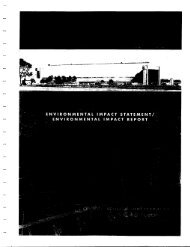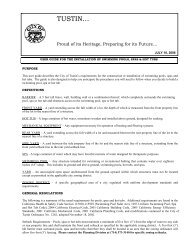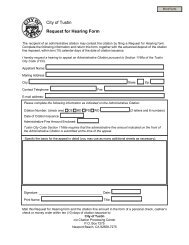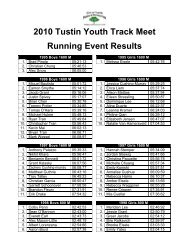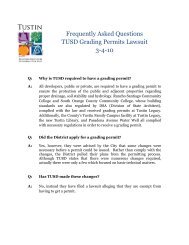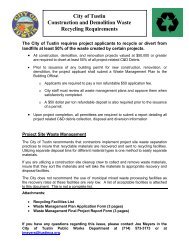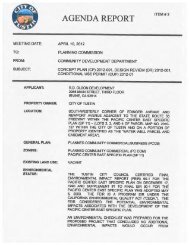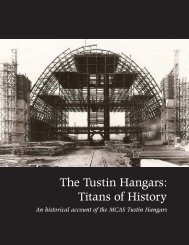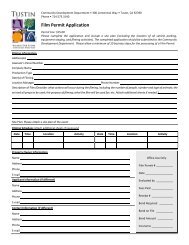the neighborhoods of tustin town center: a new ... - City of Tustin
the neighborhoods of tustin town center: a new ... - City of Tustin
the neighborhoods of tustin town center: a new ... - City of Tustin
Create successful ePaper yourself
Turn your PDF publications into a flip-book with our unique Google optimized e-Paper software.
A.3 Traffic and Circulation Testing<br />
This report presents a preliminary traffic evaluation <strong>of</strong> potential <strong>new</strong> development in three<br />
neighborhood study areas in <strong>the</strong> <strong>City</strong> <strong>of</strong> <strong>Tustin</strong> referred to as Center <strong>City</strong>, Sou<strong>the</strong>rn Gateway and<br />
West Village (see Figures 1 through 3). The traffic evaluation includes a preliminary qualitative<br />
analysis <strong>of</strong> <strong>the</strong> implications <strong>of</strong> two land use alternatives (Alternatives A and B) with changes<br />
in roadway circulation in select neighborhood areas and <strong>the</strong> potential impacts under existing<br />
conditions. The three defined neighborhood areas are evaluated separately. It should be noted<br />
that while <strong>the</strong>re are two land use alternatives in each neighborhood area <strong>of</strong> <strong>the</strong> <strong>Tustin</strong> Town Center,<br />
a number <strong>of</strong> combinations <strong>of</strong> alternatives both land use and circulation (i.e., Neighborhood Plan)<br />
could actually be paired that would affect <strong>the</strong> final development plan.<br />
ANALYSIS SCOPE<br />
The land use and trip generation for each neighborhood area will first be summarized along<br />
with information on any changes in circulation associated with <strong>the</strong> land use alternatives for each<br />
neighborhood. Next, available existing count data (average daily traffic (ADT) volumes and<br />
peak hour intersection capacity utilization (ICU) values) taken from various sources for <strong>the</strong> key<br />
roadways and intersections evaluated will be presented. Lastly, <strong>the</strong> potential traffic impacts will<br />
be discussed on <strong>the</strong> circulation system under existing conditions with potential hot spots/critical<br />
locations identified that would require fur<strong>the</strong>r and more detailed analysis at a later date.<br />
Hot spot locations can be identified in three ways in this report. First, hot spot locations are those<br />
locations that are likely impacted due to <strong>the</strong> project as defined by significance criteria and carried<br />
out in a quantitative analysis. Second, in addition to a more detailed analysis at a later date that<br />
would involve <strong>the</strong> use <strong>of</strong> <strong>the</strong> ICU methodology to determine project impact, certain areas will<br />
require a special traffic operations analysis. Those areas are designated as “Traffic Operations<br />
Hot Spots” and are locations where <strong>the</strong> standard ICU procedure does not fully depict <strong>the</strong> actual<br />
traffic characteristics. It should be noted that <strong>the</strong> ICU method <strong>of</strong> calculating <strong>the</strong> volume-tocapacity<br />
ratio <strong>of</strong> an intersection assumes isolated intersections and does not reflect any queuing<br />
<strong>of</strong> vehicles that may occur between intersections <strong>of</strong> close proximity. An example <strong>of</strong> this close<br />
proximity effect occurs on Newport Avenue and Red Hill Avenue at <strong>the</strong> I-5 interchange and <strong>the</strong><br />
adjacent intersections. Because <strong>of</strong> <strong>the</strong> closely spaced intersections, actual traffic conditions tend<br />
to be somewhat congested during peak periods even though <strong>the</strong> ICU values indicate adequate<br />
levels <strong>of</strong> service. Locations considered “hot spots” can also be sections <strong>of</strong> roadway where closely<br />
spaced intersections or side friction caused by numerous driveways degrade <strong>the</strong> performance<br />
<strong>of</strong> <strong>the</strong> roadway compared to its <strong>the</strong>oretical carrying capacity (referred to as Operations Hot<br />
Spot). Third, “hot spots” can be intersections or sections <strong>of</strong> roadway that cannot be improved<br />
to <strong>the</strong>ir full standard because <strong>of</strong> limited space due to right-<strong>of</strong>-way or o<strong>the</strong>r physical constraints<br />
(referred to as Space Constrained Hot Spot). Space constrained hot spots can reach a V/C <strong>of</strong><br />
1.00 (ra<strong>the</strong>r than a threshold <strong>of</strong> .90) in recognition <strong>of</strong> <strong>the</strong> limitations involved in making physical<br />
improvements.<br />
In <strong>the</strong> future with a more detailed study, a set <strong>of</strong> performance criteria will be utilized to identify<br />
future level <strong>of</strong> service deficiencies on <strong>the</strong> study area circulation system and also to define impacts<br />
and peak hour ICU values <strong>of</strong> significance. Traffic LOS is designated “A” through “F” with LOS<br />
“A” representing free flow conditions and LOS “F” representing severe traffic congestion. The<br />
intersection criteria involve <strong>the</strong> use <strong>of</strong> peak hour ICU values. The ICU ranges that correspond to<br />
LOS “A” through “F” are presented in Table 1. By practice, <strong>the</strong> ICU methodology assumes that<br />
intersections are signalized. LOS “D” (ICU not to exceed .90) is <strong>the</strong> performance standard for <strong>the</strong><br />
intersections in <strong>the</strong> <strong>City</strong> <strong>of</strong> <strong>Tustin</strong>.<br />
A-8 THE NEIGHBORHOODS OF TUSTIN TOWN CENTER<br />
MARKET ANALYSIS AND NEIGHBORHOOD CONCEPT PLANS<br />
STRATEGIC GUIDE 09.21.2010



